25 Willis Road Cambridge, CB1
"No dessert until you've eaten your greens." Well this post is my dessert. I wanted this blog to be more than Sinclair focused nostalgia (although that's my origin story) so I made sure to eat my greens first with articles about Amstrad and Enterprise plus, still on the to-do list, Commodore, Acorn, and Jupiter Cantab (no, really). Even better, I can use the cover of another of my favourite games Stop the Express. Which, to continue the dessert-based metaphor, is the equivalent of smothering a big scoop of chocolate ice cream in jam, evaporated milk, jelly, spangles, etc, and then be told to stop running round shrieking or I won't be allowed to watch Blake's 7.This entry initially suffered badly from overenthusiastic mission creep until I realised I didn't need to do the full company history. No one cares where Sinclair Radionics was based in 1971 (it was here). Let's pick things up in 1977 with Science of Cambridge, Clive Sinclair's second company. At the time it was being run by Chris Curry, later founder of Acorn Computers. Sinclair's first company, Sinclair Radionics, had got into difficulties over a thing called the Black Watch and was rescued by the National Enterprise Board who basically nationalised it. Later, in 1979, Sinclair resigned from Sinclair Radionics after disagreements with the NEB about the direction of the company and moved to Science of Cambridge, which appears to have been set up as something of a corporate escape pod.
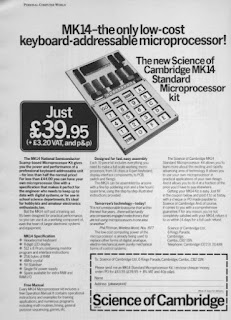 |
| PERSONAL COMPUTER WORLD April 1978 page 8 |
"The UK also had a well-established electronics hobby sector and there was incredible interest in what the technology could do. But it was very expensive technology to play with. And you couldn’t just buy a chip, you needed everything that went with it to program it."
The company ran with Williamson's idea, although they cut him out of involvement in the development; he was later paid £2000 to write a manual. The unit was on sale by, depending on where you read, late 1977 or early 1978, there's an advert in the very first issue of PERSONAL COMPUTER WORLD, and it was a tremendous success selling around 15,000 units. Writing in 1985, CRASH noted:
Reflecting this new interest in computers, Science of Cambridge became Sinclair Computers in late 1980 and then Sinclair Research in March 1981. You know the drill. 1980, ZX80. 1981, ZX81. 1982, ZX Spectrum. Each computer was ground breaking in its own way, and increased knowledge of computers among the general public, and widened the userbase, and was low-cost and offered enough of an incremental step up that people who owned one felt justified in upgrading. Starting with the ZX81, PERSONAL COMPUTER WORLD gave the cover to each new computer, and a monkey.
"That it was far too early a date is now well known, but just who realised that at the time when it was fixed is unclear. As we have said before, it was part of the [Sinclair Research Managing Director] Nigel Searle management technique never to prepare any sort of schedule showing who was going to do what and by when. Such an approach, he averred, leads people to take more time than they should. If you tell them the launch date, it gives everyone something to aim at. So Sinclair management 'agreed' the launch date with the engineers, with the proviso that the product would not be ready to ship in bulk until the end of February 1984"
"Sinclair Research appears even more determined not to look back and learn from the mistakes of the past. In all respects save one, the company policy has remained the same, presumptuously assuming that customers are content to await the delayed delivery of the QL and attempting to placate the irate with promises of a gift as compensation. Remember that £10 voucher given to those who suffered the Spectrum delays?
The MK14, for such it was, had a very early 8 bit processor, the SCMP or 'SCAMP', which was programmed in machine code — although a very tiny BASIC soon became available. And the manual included a program for 'Lunar Lander' the very first game playable on a Sinclair computer!
The MK14 changed the direction of Science of Cambridge. Before this Clive Sinclair hadn't been massively interested in computers. He'd given an interview to ELECTRONICS TODAY INTERNATIONAL, ETI, for their 1977 special issue ELECTRONICS TOMORROW and told them: "I think there's not much use for the computer in the home. I think what will change our lives much more is robots." Although he does also say:
"I'm waiting to see what happens. I think the programmable calculator is, in a way, a venture in that direction. Evolutions of that type of product might meet that demand. It's hard to see which way it's going at the moment. We've spent an awful lot of time looking into this problem and we're still not definite which way we'll go. But I suspect it'll be from calculators upwards to computers... In 1984 we'll be more into computers than we are now. We see ourselves as on the beginning of computers with the programmable [calculator]. I'm sure that will have gone a lot further by then."
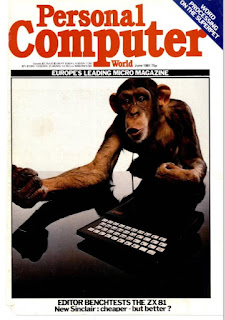 |
| PERSONAL COMPUTER WORLD June 1981 |
1984 was the year the wheels began to wobble. The The Sinclair QL (working name ZX83) was aimed at the business market and according to THE SINCLAIR STORY (page 134): "...it was a deliberate Sinclair policy to discourage software houses from writing games for the ZX83... Sinclair felt that games would undermine the authority of the ZX83." The QL launch was rushed for reasons that genuinely don't seem clear. According to the SINCLAIR STORY (page 136):
 |
| PERSONAL COMPUTER WORLD June 1982 |
It's possible Sinclair Research was spooked by the announcement of the Enterprise Elan and Amstrad CPC, all more or less aimed at the same gap in the market. Anyway, an initially positive response turned sceptical as orders were delayed and February turned into March and March turned into May. "I have cancelled my order. I have also written to the Advertising Standards Authority," wrote a correspondent to PERSONAL COMPUTING NEWS. By June SINCLAIR USER was describing the launch of the QL as "1982 revisited":
 |
| PERSONAL COMPUTER WORLD June 1984 |
Only in its advertising has the company acknowledged past errors. Heedful of the ASA breathing down its neck, it has inserted in recent advertisements for the QL the phrase: "Due to demand, delivery may take more than 28 days". At least the uninitiated now know what to expect.
One thing however, is certain and that is that the computers on show at the January press launch were not fully operational and were only representing ideas-in-progress. Time will tell whether those ideas have come to fruition."
THE SINCLAIR STORY wrote: "At the launch in January 1984, Clive spoke of QL production
building up to 100,000 per month. In fact, fewer than 60,000 machines were sold in that first year." (page 142).
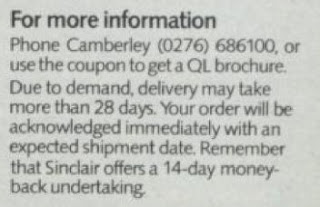 |
| SINCLAIR USER April 1984 page 23 |
Out of nowhere in October 1984, Sinclair introduced a redesigned ZX Spectrum. It was the same as the standard 48k model but with what the advert described as a "new style... professional keyboard."
Chris Curry moved Sinclair Research into offices at 6 Kings Parade. According to The Sinclair Story (page 89) he borrowed £500 from his dad to pay the first month's rent and buy some office furniture. Even in 197-something-or-other this seems like an insanely low amount to pay because the building is dead opposite the huge gothic frontage of King's College. A fact confirmed by any photo of Clive Sinclair at his desk. Behind him, through the window, you can see the pinnacles and "bulbous cupola" (© Nikolaus Pevsner) of the college gatehouse. I sat opposite Kings Parade and ate some chips which must have knocked about £500 off whatever is the current monthly rent. These days the ground floor of 6 Kings Parade is a meditation/yoga centre called Inner Space. I was tempted to see if they'd let me go up on the first floor and look at Sinclair's old office but fortunately the shop was closed. To give you some idea of how posh Kings Parade is, it has its own Wikipedia entry which includes a lovely (public domain) picture from circa 1870. Number 6 is just visible right in the middle. It hasn't changed.
Sinclair Radionics had been based at the Mill since 1970 and Sinclair Research kept a presence there even after Clive Sinclair bailed in 1979. THE SINCLAIR STORY (page 97) says the flat-screen television project was based there in a "self-contained building on the Mill site," called Durcam Hall. The Old Mill is about 11 miles from Cambridge and it wasn't possible for me to get out there when I was in the area, so it goes on the to-do list, but here's the 1982 photo.
I didn't find Who's Who at Sinclair until after I'd visited Cambridge and so I didn't know about the existence of the Bridge Street offices until it was too late. Grr. That's another one for the to-do list. The Bridge Street office is a little under half a mile from Kings Parade. It's closer to the offices of Camputers at 33A Bridge Street. From March 1983 to June 1984 Camputers sold the Lynx, a rival to the Spectrum, then they went into receivership. Sinclair's Bridge Street office is also close to the pub called the Baron of Beef, of which more later. This link to Streetview will have to do in the absence of a real picture.
CRASH noted, in a slightly sour way, this limited redesign as "confirming [Sinclair's] attitude to the machine that they do not see it as a games machine. Nothing has been done about the sound or colour attribute problems associated with the video display." SINCLAIR USER gave a little more background:
Sir Clive Sinclair says the product is aimed squarely at potential buyers of the Commodore 64, "Market research showed people thought the Spectrum was a better computer, but preferred the Commodore 64 because of its keyboard."
And then went on to quote Sinclair directly with a line which showed how stung he felt by criticism of the QL.
The decision to launch the package without advance publicity was taken because of criticism over the handling of the QL launch. "We wanted to make absolutely sure the Spectrum + was in the shops when it was launched," says Sir Clive. "Otherwise nobody would have believed us".
The wheels wobbled in 1984. They fell off in 1985. The failure of the Sinclair C5 falls outside of the scope of this blog but if you want to know more I recommend Tim Harford's podcast Cautionary Tales and the episode called The False Dawn of the Electric Car. The failure of the C5 might have taken down Sinclair Research but fortunately manufacturing had been spun off into another company, Sinclair Vehicles.
The post-Christmas slowdown in computer sales saw a round of price cuts. Sinclair reduced the price of the Spectrum+ in January 1985, from £179 to £129. Then Acorn cut the price of the Electron from £199 to £129, and offered £50 off to anyone buying a BBC Model B and trading in their old computer at the same time. Meanwhile Commodore cut 100 jobs from their Corby factory due to a fall in demand. Acorn's shares were suspended in February against a background of rumour and speculation, and the appointment of a new temporary chief executive. A creditor issued a winding up order. Then Acorn was taken over by Olivetti. At the same time Sinclair's main hardware distributor Prism entered receivership owing Sinclair somewhere in the region of £1 million. This was the backdrop against which Sinclair was trying and failing to raise funds from the City. CRASH summed up Sinclair's problems in July 1985:
The official line from Sinclair, reported in the Financial Times, was that the company was aiming to raise £10 to £15 million 'to fund long-term growth and restructuring plans'. It's clear that Sinclair Research is experiencing some financial difficulties... Thorn EMI and Timex have extended credit to Sinclair to aid cash flow problems. Two and half million pounds have been written off by Sinclair Research as a result of the price cuts made after Christmas in combination with returns, and a further million pound loss was incurred by the demise of Prism - which apparently caused such major problems to the company, that Sinclair is still trying to work out quite what went where.
Ten percent of Sinclair Research was sold to shareholders a couple of years ago for 13,5 million, and even the most mathematically untalented could work out that the share sale valued the whole company at £135 million. Recently a report in The Guardian placed a value of £20 million on the whole company.
Robert Maxwell got involved. He didn't save Sinclair. The proposed deal fell apart. I covered the details in the Mirrorsoft article but to recap: The takeover would be carried out via Maxwell's Pergamon Press subsidiary Hollis. THE DAILY MIRROR (17 June 1985), "The Sinclair company will raise £12 million cash by issuing new shares. Hollis will take up most of these shares. Rothschilds [Sinclair's bankers] will ensure that the rest are sold to other investors." It was all over by 10th August when THE DAILY MIRROR reported, "on advice from their City bankers, Hill Samuel, Hollis directors decided they could not recommend the deal to their shareholders. Mr Maxwell said last night: "we are sad that it was not possible to conclude the deal. But it just didn't gel."
Dixons threw Sinclair Research a lifeline with a deal worth £10 million. SINCLAIR USER reported:
Dixons has taken 160,000 Spectrum Plus computers and televisions.
They will go on sale in its 800 stores which include Currys outlets, Dixons are packaging the Spectrum Plus, cassette recorder, joystick and a ten-pack of Sinclair brand software for £139.99. A package which incorporates the computer, pocket television and live software titles is being sold at £199.99.
Sir Clive sees the deal as a turning point for Sinclair Research, "The deal with Dixons shows the light at the end of the tunnel. At this time I have no idea why Bob Maxwell pulled out, he may have other fish to fry. I don't think that we need anyone to rescue us."
Sinclair unexpectedly launched an upgraded 128K Spectrum in late 1985, in Spain. There had been rumours since May 1985 but they were consistently denied by Sinclair until the new machine was launched at the Barcelona Computer Fair on Monday 23rd September (POPULAR COMPUTING WEEKLY, 26 September-2 October 1985 page 1). Why Spain? SINCLAIR USER (November 1985 page 5) quoted Charles Cotton, director of sales and marketing at Sinclair Research: "The impetus to introduce a Spectrum 128 in Spain comes from the peculiar market forces operating there. It is a very important market for us, as we account for over half of the home computers sold in Spain." Lucky old Spain. The UK would definitely not see the 128k Spectrum until after Christmas 1985; PCW speculated this was to avoid undermining sales of the Spectrum Plus and threatening the Dixons deal. Dixons got its Christmas and the new Spectrum was launched to the UK press on 13th February 1986. SINCLAIR USER got a scoop (February 1986 page 7) because Design Design appears to have accidentally sent the magazine review copies of their games Forbidden Planet and 2112AD:
Just weeks after the Spanish launch software companies were seen to be gearing up for new products which, they all said, were under wraps. The companies were under strict contract to Sinclair Research not to reveal anything about their new products. As far as the press and the public were concerned the software was meant for the Spanish market. That would have seemed reasonable if software packages had not started to arrive with Spectrum 128K as well as 48K plastered all over them
The company which dropped the clanger, but which is being quiet about it is Design Design.
The company which dropped the clanger, but which is being quiet about it is Design Design.
Other magazine scrambled to make the 13th February launch date fit with their print deadlines. CRASH was able to fit in a quick two page technical review by Franco Frey; in an issue which doesn't have the usual news pages, were they knocked out to fit in the review? CRASH's real review came in the April 1986 issue. Reaction to the new machine was positive and companies were quick to release titles taking advantage of the better sound and extra memory. Two Ocean games, Daley Thompsons' Supertest and The Neverending Story were given away with the computer, and there were upgraded games from Odin, Domark, Hewson, and more. Sadly we never got to see the original Dragon's Lair-style version of Scooby Doo which SINCLAIR USER speculated Elite might consider for the 128K Spectrum after memory issues put paid to the planned 48K version.
"The announcement that Amstrad has bought Sinclair Research, made a few hours before this issue of CRASH went to press, is the most significant development in the UK home computer market since the launch of the ZX80."
After weathering the storms of 1985 Sinclair was suddenly done. CRASH broke the impossible news in the May 1986 issue. Amstrad had brought the intellectual and marketing rights for Sinclair's computers for £5 million. The deal extended the shelf life of the Spectrum and would keep it in production until 1992 but at the time it felt like a failure or, as CRASH headlined the news, "Sugaring Sinclair's Bitter Pill?"
Much to my surprise, Sinclair Research is still running today (Company number 01135105). I couldn't understand why I couldn't find it in the Dissolved Company search. It turned out the simplest explanation is correct. I just assumed the company was dissolved at some point between the Amstrad deal and the present, in fact Sinclair Research has become a holding company; one that exists just to hold a controlling interest in other companies. That said, the company seems to be listed as dormant these days and the saddest entry on the record is the document dated 7th October 2021, "Cessation of Clive Sinclair as a person with significant control on 16 September 2021". The date Clive Sinclair died, aged 81.
Sinclair Research released a lot of software but not many games. Horizons, by Psion, would be the title most people were familiar with, a compilation that came with the original Spectrum and was designed as an introduction to the machine. There were eight programs on the tape and only one of them was a game; Thro' the Wall, a BASIC version of Atari's Breakout. There was also a range of educational software released in association with Macmillan under the umbrella title of Science Horizons; there was Cargo, in which players attempted to badly load a ship to see how fast it could sink; Survival, in which players learned if a mouse could eat a hawk; and Make-a-Chip in which players designed microchips in order to learn just how boring it was possible for software to be. Firmly in the games camp were titles by Psion; Chequered Flag, Match Point and the Horace trilogy of Hungry Horace, Horace Goes Skiing, and Horace and the Spiders. Oddest of all were four games by Japanese company Hudson Soft; Bubble Buster, Driller Tanks, Eric and the Floaters, and Stop the Express. The packaging for all four games carries a 1983 copyright date for Hudson Soft and a note above the Sinclair address, "first published in 1984 Sinclair Research Ltd". I can't account for how a Tokyo-based company ended up converting four games to a computer which wasn't released in Japan. A POPULAR COMPUTING WEEKLY report simply notes:
A Sinclair spokesman explained that there was no special relationship between Sinclair and Hudsonsoft: "They approached us with their material some of which we liked very much."
All four games were also released for the MSX, which shared the same Z80 processor as the Spectrum, and this would have simplified the conversion. I also can't explain how Bubble Buster became the arcade game Pang six years later. Or, why Eric and the Floaters wasn't released under its more well known, and massively successful, name Bomber Man. Wikipedia claims: "The European home computer versions were released as Eric and the Floaters to avoid any association with a series of terrorist bombings carried out by the Irish Republican Army during The Troubles." To which I raise a surprised (and slightly cynical) eyebrow. What I do know about Stop the Express is it has a lovely "Well Done" message at the end.
Presumably, no one at Sinclair could stop the express and so the message was never proof read.
Sinclair was a company that outsourced as much as possible, so they are really spread out across the country. With that in mind here's a list of their addresses.
6 Kings Parade, Cambridge, CB2
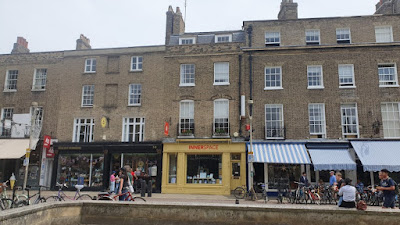 |
| July 2023 |
 |
|
Who's Who at Sinclair, 1982
Page 7 |
Knocking around online is a booklet referred to as Who's Who at Sinclair, 1982. A directory which lists Sinclair Research's various offices and gives brief thumbnail sketches of everyone working for the company. It includes photos of all 44 employees and catches the company at a very specific time when it's spilled out of the tiny suite of offices in Kings Parade and before the company tries to consolidate its Cambridge workforce at 25 Willis Road. It's also in full colour. This was expensive in 1982 and the money spent turning a simple corporate directory into a prestige product gives an indication of how successful Sinclair Research was at the time; or at least how the company wanted to be perceived as successful. Best of all, for me, it also includes contemporary pictures of each building. Here's the one for Kings Parade showing how Clive Sinclair was working above a branch of Lunn Poly travel agents; get away.
 |
| 1982 |
The Mill, 50 London Road, St Ives, Cambridgeshire
 |
| 1982 |
27/28 Bridge Street, Cambridge
 |
| 1982 |
And here's the real thing, taken in August 2024 and uploaded in November because I am inefficient.
29 South Gate Street, Winchester, Hampshire S023 9EB
Another discovery from Who's Who at Sinclair, 1982 and another one for the to-do list. Grr x2. Here's the Streetview link, the building hasn't changed at all in 40+ years. The internet is vague about what went on in Winchester. Only two people worked there, Graham Beesley and Michael Pye. Who's Who at Sinclair, 1982 describes them both as working on "semiconductor based products."
[20/3/2024] To-do list reduced. This is what 29 South Gate Street, Winchester looks like now. It looks exactly the same as it did in 1982. You'll notice I took the picture back in January and failed to upload it for three months; surely some sort of record.
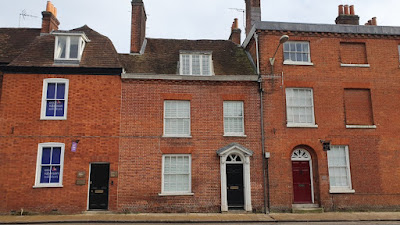 |
| January 2024 |
23 Motcomb Street, London, SW1X 8LB

|
| July 2023 |
Motcome Street is in Belgravia. To get there I walked passed an assortment of embassies; Boliva, Norway, Spain, and Portugal. It was to this rarefied atmosphere that Clive Sinclair brought his London office. It's listed in Who's Who at Sinclair, 1982, which suggests the move took place that year. Motcomb Street is super très chic, although I'm not sure what's going on in the window of the shop opposite.
25 Willis Road Cambridge, CB1
 |
| SINCLAIR USER ANNUAL 1984 Page 63 |
Sinclair Research moved into Willis Road some time in 1983. THE SINCLAIR STORY describes the building as:
...what was once a rather dingy group of industrial buildings. These had started life as Barker and Wadsworth's spa water bottling plant; after various vicissitudes the property came into Sinclair's hands....
The main L-shaped building had been restored to its original appearance and now contained offices and research laboratories. The former outhouses had been completely remodelled as a general office area with the exterior clad entirely in stainless steel. The yard between the building and the outhouses was transformed into an enclosed atrium (an LG&H speciality) and featured a 'fine bronze sculpture' by Helaine Blumenfield. Even the bicycle shed was fine art.
Over on Youtube there's a short 14 second video of Clive Sinclair inside the new building walking along what can only be described as the top of a death trap staircase.
Willis Road is a quiet residential street and the Sinclair Building is tucked away in the far corner, in the right-angle gap between the ends of two terraces. It has clearly fallen on hard times. The gate is locked and secured with an intercom and I was undoubtedly on CCTV as I knelt down to try and get a photo that included the sign -which is fading badly, someone needs to get on refreshing that quickly.
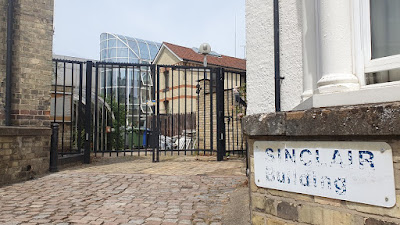 |
| July 2023 |
The immediate impression through the gates is of an abandoned jumble sale. The view doesn't get any more inspiring as you get closer. The open car park is now blocked off behind a wooden fence. The "work of art" bike shed is rusty. Plants are growing out of control. The Sinclair Building is now part of Angela Ruskin University, possibly used as an IT and data centre, although judging by the state of the courtyard a bin store and dump seems more likely.
50 Staniford Street. Boston, Massachusetts, MA 02114
 |
| 1982 |
Sinclair wanted to sell the ZX80 in the United States, although he did not expect to find an enormous market there because of the strength of the competition in the home computer field. However a
few weeks before the launch of the ZX80 in the UK he took it to the Las Vegas Consumer Electronics Show and at the same time met Nigel Searle in Boston. Within a few days Searle had a new job, a new apartment and an office in Boston. He sold the ZX80 and later the ZX81 in the States from that office by mail order until early 1982
The block is still there. Streetview shows it looking pretty much as it did in 1982.
2 Sinclair Plaza, Nashua, New
Hampshire 03061.
Sinclair Research or more likely Timex Sinclair, the joint venture between Sinclair and Timex, the contractor who made Sinclair computers at a factory in Dundee, had premises in New Hampshire. This bit is speculation but given the timeline I think this followed on from the Boston office. The company was ultimately unsuccessful and was dissolved in 1984, it deserves more space than I can give it here (what with it not being a UK company, etc). Timex Sinclair did create a few ripples on this side of the Atlantic, when US company SoftSync Inc licenced a few UK games for release in America, and Design Design ended up releasing two SoftSync games; Bug Blaster and Cyberzone. YouTube channel 8-Bit Retro Journal took a trip to the building just two months ago, in 2023, and you can watch the video here.
28 Stanhope Road, Camberley
If you wanted to buy an MK14 in 1978 you ordered it from 6 Kings Parade. The same was true for the ZX80 and ZX81
1 . By 1982 a different mail order address was being used, one in Camberley in Surrey. According to THE SINCLAIR STORY (page 48) "Sinclair believed that a company which designed, but did not manufacture, its own products, could be more responsive to market trends." Although the book also notes: "Clive Sinclair was determined to keep [Sinclair Research] to a manageable size; he was all too aware of the need to try to learn from previous mistakes. Bringing manufacturing inhouse in the days of Sinclair Radionics had seemed an excellent idea at the time, but the number of people they had had to make redundant had hurt him deeply." (page 97).
This led to the company using a lot of subcontractors, including a distributor called GSI who were based at 28 Stanhope Road. GSI began working with Sinclair in 1980 on the distribution of the ZX80 (SINCLAIR USER ANNUAL 1984, page 68) but it wasn't until 1982 that they became the public face of the company handling customer enquires, mail orders, complaints, and distribution of Sinclair products. SINCLAIR USER describes the GSI buildings as "small offices and a warehouse on a featureless industrial estate," but disappointingly doesn't include a photo of the exterior, although it does have a couple of nice photos of the staff and warehouse interior.The GSI building is long gone and Stanhope Road has become one of those confusing streets where redevelopment has messed up all the building numbers. A Streetmap search for number 28 results in the red dot hovering unhelpfully in the middle of the road. Jumping to Streetview at the site of the red dot reveals a demolition site on the south side of the road, with a sign reading "9 Stanhope Road," helpfully pinned to the hoarding and on the north side this beast of a building.
It's a Bank of America building. What they do in there is anyone's guess. Judging by the fence and the number of CCTV cameras this could be the secret home of the The United States Bullion Depository. Well, it's obviously not in Fort Knox is it? You don't paint a giant target on a big obvious building and then actually use it to store what's claimed to be there. Next door to Bank of America is a big grey, windowless building, which my memory persists in claiming filled the street with a low hum; but I think my memory is overdramatising. Steetmap calls it the Lincoln Rackhouse Data Centre. That whole side of the street reeks of security. I was glad I'd visited on a Sunday. When I took the picture I half expected to be dragged inside by the baddies from Tron. As it was, I think an unmarked black helicopter followed me home. Paranoia aside, I'm pretty sure the remains of the GSI building are somewhere under the Bank of America/Data Centre site. If you want an idea of what the area used to look like, the buildings on the south side of the street give a better idea.
 |
| March 2023 |
Unit F Broad Lane, Cottenham, Cambs, CB4 4SW
 |
| POPULAR COMPUTING WEEKLY 3-9 March 1983 page 6 |
This is probably another subcontractor, maybe a local distribution firm or mail order specialist. You can tour round the industrial estate on Streetview, and Unit F is still there, looking much like it must have done in 1983. I nearly took the bus to Cottenham when I was down in Cambridge but I missed it by five minutes. In retrospect I'm glad I did. It's always tricky photographing places like this during working hours. It would also have eaten up too much of my day and for reasons which will become clear soon, I wanted to spend some time walking around Jesus Green in Cambridge.
Timex Factory, Harrison Road, Dundee
This was where your ZX80, ZX81 and Spectrum were made. Tek Electronics in St Ives were an early subcontractor for Sinclair Radionics products but the computers were made in Dundee. The factory building is still there but unfortunately Timex is not. When Amstrad took over in 1986 manufacturing shifted to Taiwan and the factory closed in 1993 after a seven month strike.
And now we move on to the miscellaneous section.
The Hoover Factory, Pentrebach, Merthyr Tydfil
This was where the Sinclair C5 was manufactured. Not really related to Sinclair Research, separate company and all that, but I was in the area so what was I going to do, NOT stop and take a photo?
 |
| September 2023 |
The Baron of Beef
 |
| July 2023 |
 |
| DAILY MIRROR December 15 1984 page 10 |
The pair met in the Baron of Beef pub on Friday 21st December. This UPI archive report quotes Sinclair as calling Curry "scum" and whacking him with a rolled-up newspaper. A much later report in The Register on the making of Micro Men, BBC4's drama on the rivalry between the pair, noted "The dialogue - “You fucking buggering shit-bucket!” - was taken verbatim from Curry’s telling of the tale." On Christmas Eve 1984 the Cambridge Evening News made the fight a (bottom of) page one story:
Amstrad, desperate to get mentioned in the news, frantically me-as-well'd their way into the story by claiming to be about to release a game called This Business is War featuring likenesses of the two computer tycoons. BIG K picked up the story in its final issue (March 1985 page 8). "We have to be careful about what we depict," the magazine reported an Amstrad spokesman as saying, "but suffice it to say that if the Sir Clive lookalike should be vanquished -he will be carted off to hospital in something that has an uncanny resemblance to a three-wheel electric car." Oh! My sides. The game never appeared.
The search for the QL advert location
In late 1984 Clive Sinclair did this.
The question is, where was the advert filmed? I asked Where Were They Now?'s Cambridge correspondent who suggested Jesus Green. A big open space by the river in the city centre.
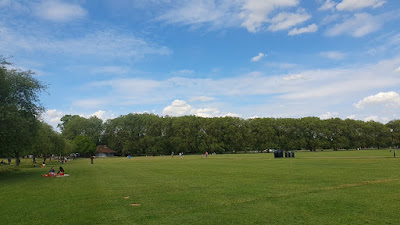 |
| July 2023 |
It's certainly the right sort of area. A large, well maintained, tree-lined expanse with paths and even a tennis court (briefly glimpsed off to the side in the advert) but it doesn't quite fit. I spent an hour or so walking round the park and it just doesn't feel right. The problem is, the park is a public space. If the commercial was filmed there I'd expect there to be a record; and there isn't. No local newspaper reports that I can find, no charming online anecdotes from people remembering the day they saw a stuntman dangled from a crane while pretending to be Clive Sinclair. If it wasn't filmed in a public location then it may not be findable... except... some time in 1984 (it's difficult to be precise) Sinclair Research purchased a place called Milton Hall on the outskirts of Cambridge. These days it's "unique and prestigious offices," with "six acres of landscaped gardens." Six acres, eh? Just the sort of place you might set up a crane and some foreground miniature computers for a quiet couple of days of undisturbed filming.
All I've got to go on are the overhead views from Google Earth but even after a chunk of neighbouring land has been developed, it's clearly a large, well maintained, tree-lined expanse with paths. There's a sports pitch down by the building labelled as North Lodge Pavilion. It doesn't seem unreasonable to speculate there could have been a tennis court in the eighties. Ultimately there's no way to be sure but it's a good guess (if I say so myself). Sinclair had houses in both London and Cambridge and if you are going to involve the boss in your commercial you are going to want to make sure it's reasonably convenient for him.
Do you know where Clive Sinclair went to film the QL advert? Do you live in Boston, New Hampshire or Dundee and can email in a picture of the relevant location? Leave a comment or email whereweretheynow@gmail.com or post it on Twitter @shammountebank or (gasp) try and do whatever the heck it is you are supposed to do on Instagram at https://www.instagram.com/shammountebank/ (probably. I don't know how Instagram works).
1 In my self appointed role as Killjoy-in-Chief I tried to track down the source of the often reported story that Clive Sinclair once claimed a ZX81 was powerful enough to run a nuclear power station. [Topical 1986 joke goes here]. I couldn't. The closest match I could find was the line in the ZX80 advert that "The ZX80 is programmed in BASIC, and you could use it to do quite literally anything from playing chess to running a power station." If you know differently please email in or leave a comment, etc, etc.

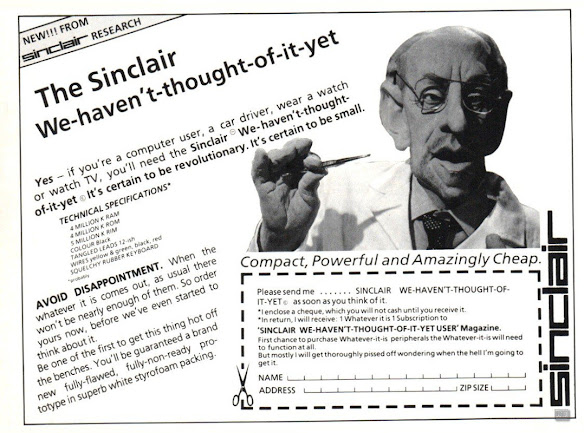


















No comments:
Post a Comment